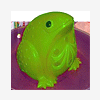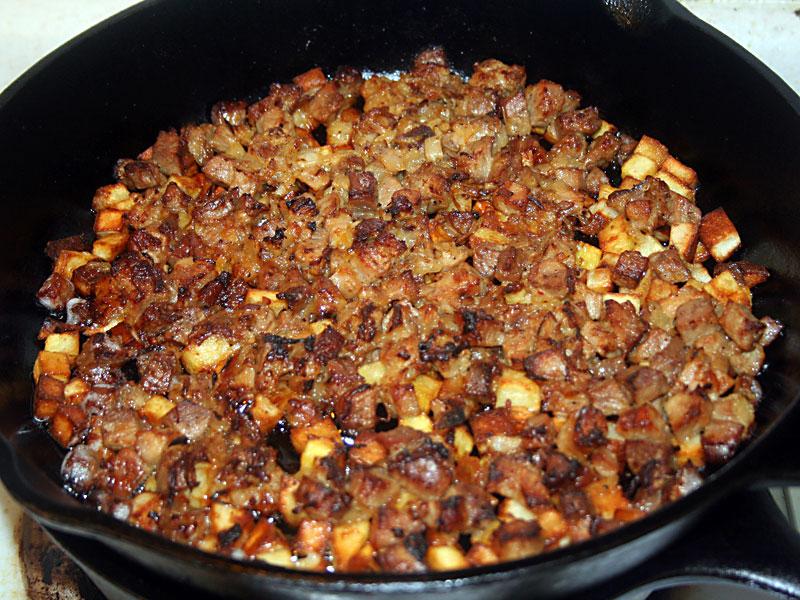-
Posts
8,089 -
Joined
-
Last visited
Content Type
Profiles
Forums
Store
Help Articles
Everything posted by Dave the Cook
-
Here in Atlanta, we can usually find beef back ribs in slabs or cut into individual pieces. I find the latter inexplicable, but they must be popular, as they're often easier to find than the slabs. Structurally, they're almost identical to (pork) baby backs, just bigger. I heat the oven to 350°F, salt and pepper the ribs (or sometimes use a dry rub, depending on my mood, timing and the rest of the menu). The ribs go in, and I turn the oven down to 225°F. I flip them every 30 to 45 minutes, though I'm not sure it makes a difference. Somewhere around 2-1/2 hours, the meat starts to draw back from the end of the bones and the rack becomes very flexible. If I'm going to glaze them, this is when I do it. The low temperature dehydrates the glaze without danger of burning, and you get a lovely, sticky mess. When the meat has pulled back nearly an inch -- this will take another 15 minutes or so -- they're done. I think flanken are not back ribs but short ribs, which come from the chuck.
-
At the Heartland Gathering this year, we made an aged Gouda "crouton" with sherry instead of beer. As Tom Noe's excellent photo of it here shows, it worked fine. Tasted good, too.
-
I wonder if the 350 figure in the dish recipe just got transferred from the lentil-component recipe. 350g grams of dry lentils will weigh a lot more after cooking. Of course, it would also make for a lot of salad.
-
It's worth looking at the bolster/handle design of Shun's Ken Onion line. They're not for everyone -- you have to have the right-sized hand for it to be truly comfortable -- but here's what I've observed many times in our beginners' cooking classes: there are always one or two people who just can't figure out the pinch grip, no matter how we describe it, demo it, or explain the advantages of it. Once we wrap their fingers around a Ken Onion, though, light bulbs go off.
-

Common Food Mispronunciations and Misnomers
Dave the Cook replied to a topic in Food Traditions & Culture
Michael Symon says -- in a Calphalon commercial -- CAL-fa-lon. Video here. -
The CI crowd can be condescending, smug, unnecessarily circuitous in their thinking (including many a trip through the land of the Straw Man), and downright boring at times, but they're rarely out-and-out wrong. So I can't account for their results. Damage to avocados seems to have a threshold of 45°F/7°C. Trucks and trains headed to New York get cold, I'm sure, but probably not that cold -- ruining a semi-trailer full of expensive fruit seems like a quick way to go out of business, so there must be a way to mitigate temperature. Or maybe they come in the hold of a boat.
-
McGee, On Food and Cooking (second edition), p 277: p 337: From the first edition, p 202-203:
-
You got some bad advice. Cold actually damages unripe avocados. Depending on the species, if you take them out of the refrigerator now, they'll likely go straight to rotting.
-
I was going to embark on a long explanation, but the Serious Eats link says it pretty well:
-
It's not worth the trouble to caramelize sweet onions; they don't fare well in long cooking applications. We use them for onion rings and in salads. They're also good when quickly grilled, or sometimes as part of a stuffing.
-
David is onto something when it comes to texture and the contrast between the egg and the crispy parts of the hash. But I also appreciate the extra volume of sauce -- in the form of yolk -- that a poached egg provides.
-
Dude. Poach an egg. Instructions here. Or here. It really makes a difference.
-
I think -- very generally -- that prepared mustards are half-seed, half-liquid, much of which is vinegar and the rest water, wine or verjus. So it seems like you could start with milled seeds in half the amount of prepared that you would normally use. Dilute it with water or stock, maybe?
-
I think that's hash, but I worry about the evident lack of ambition: that egg is not poached.
-
Why not use mustard seed or mustard flour?
-
I think Keller's prejudice is the result of two things: the sort of food he usually handles, and watching amateurs (including cooks right out of school) misuse an otherwise valuable tool. Keller directs the reader to a photo of him using a palette knife to turn scallops. That makes sense to me; if you use tongs, you might be more likely to tear an insufficiently seared scallop. With the knife, you really have to wait for proper browning before you can turn. But what works for a two-ounce bivalve won't work for a two-inch-thick ribeye (or, I suspect, the 2-1/2 pound short rib he calls for on page 41 of Ad Hoc; I wonder how he manages that). Having just spent three days teaching a "kitchen basics" class, I can say that many folks approach tongs in a manner very similar to the way they handle their first really sharp knife. They're uncomfortable with them; they treat such implements the way other people might handle a gun or a very fast car for the first time. As a result, they tear the skin off of chicken thighs while searing and they crush sauteed zucchini. But nearly every one of them leaves class with a pair of tongs, convinced of their ultimate utility, and the need for practice.
-
Grade B isn't as prevalent as A, but it's not hard to find. When I lived in Houston (late 90s), it was available at all the major grocery stores. Here in Atlanta it's the same story: of the three or four brands on the shelf, at least one of them will be B.
-
I'd scour eBay for a Cuisinart Little Pro Plus. They're not made any more -- I suspect because they weren't profitable for the company -- but mine is still going strong after eight or so years.
-
If you were making it for me, yes. I think a successful hash hath crispiness to a more than nominal degree.
-
I think it's a challenge if you're going for "crispy" -- potatoes are good at "crispy outside/fluffy inside." But I could see other starches working under the right circumstances. Bean, rice and grits cakes can all be crispy.
-
I don't find that there's big difference in taste among potatoes (for example, I don't know what you mean by "meaty"), particularly when there's lots of other stuff going on like there is in hash. The significant difference for me was that I was starting the potatoes from scratch, and I didn't want to parboil -- in fact, in the size I used, parboiling seemed superfluous. In this case -- going straight to the pan -- the waxy type seemed the better bet.
-
Our hash was made from pork shoulder and two potato varieties, Yukon Gold and mature reds. We were shooting for a crispy crust, especially on the potato. Several folks have suggested getting the potatoes 3/4 of the way done before adding onions (and peppers, which we didn't use) to help avoid softening the potato surface, but we went a step further, doing the onions and meat separately, then adding them at the last minute. Here, more or less, is the recipe: 2 C roast pork, finely diced (1/4") 2 C waxy potatoes, finely diced 1 C chopped onion 2 cloves garlic, minced 1/2 C rich stock (we used beef, but it probably doesn't matter) 1/4 C heavy cream 2 t pork fat 1 T duck fat (Yeah, the fats are odd, but we had the pork fat leftover from the roast, and duck fat was close at hand -- plus poultry fat + potatoes = some kind of magic.) Heat oven to 450°F. Cook the onions in the pork fat until they separate and pick up a little color. Add the pork and stock and heat through. Add cream and reduce slightly. Adjust seasoning. Brown the potatoes in duck fat with a little salt until crispy. We used a cast-iron skillet, because we knew we were going to put it in the oven, but any oven-safe saute or fry pan will do. Pour the meat-onion mixture over the potatoes, being careful to disturb the potatoes as little as possible. Put the pan in the oven for about ten minutes, until top is browned and liquid has thickened. Plate and top with poached egg, if desired. Here's the hash right out of the oven: And here it is plated, with an egg and scallion garnish: This was an excellent example of a "crispy-with-separate-bits" hash. The potatoes retained their crunch, the meat picked up a little crust, and the brief stay in the oven brought the liquid down to a glaze, leaving enough moisture (along with the egg as sauce) to prevent dryness in the mouth.
-
Got it. Your method makes sense, since tots were originally devised by Ore-Ida as a way to use up shards left over from making fries, weren't they? I'm wondering if you're not going to have to add another step for authentic tot crunch -- some starch, or pre-frying or something. Otherwise, you've just got irregular potato shapes. Or maybe that's what you want.
-
I'm not clear on the result you're trying to achieve. Do you want to recreate tots ("gems" to our friends down under) as a component of the hash, or are you after something much smaller, like a tot "crumb" -- maybe 1/16" inch?
-
saturnbar is correct. The commercial standard for Creole mustard is Zatarain's, and the ingredients are as simple as can be: vinegar, water, brown mustard seed, salt, xanthan gum.



